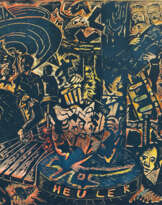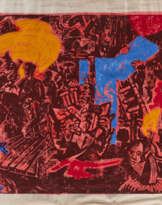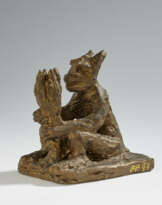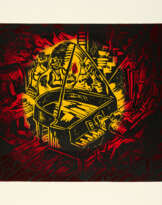ID 1066880
Lot 83 | Jörg Immendorff (1945 Bleckede/Elbe - 2007 Düsseldorf) (F)
Estimate value
€ 3 000 – 5 000
Jörg Immendorff (1945 Bleckede/Elbe - 2007 Düsseldorf) (F)
'The Rake's Family', Mappe mit 11/+1 Farblithografien auf Hahnemühle Bütten, Titelblatt, Vorwort von Christian Ahrens, je 140 cm x 100 cm Blattmaß, herausgegeben von Quensen/Steinmann, Lamspringe Oktober 1995, je signiert, 95 datiert, 29/33 nummeriert, Trockenstempel, im Druck betitelt, teils bezeichnet, auf dem Titelblatt nummeriert, Blattränder partiell bestoßen, minimal knickfaltig, Literatur: Wvz. Geuer 1995.1.1-1.12
Im Jahr 1994 übernahm Jörg Immendorff die Aufgabe, das Bühnenbild und die Kostüme für eine Neuinszenierung von Igor Strawinskys Oper "The Rake's Progress" ("Der Werdegang eines Wüstlings") bei den Salzburger Festspielen zu gestalten. Diese künstlerische Unternehmung führte ihn in einen faszinierenden Dialog mit der Oper selbst, die wiederum auf den visuellen Werken des englischen Malers William Hogarth basierte. Zwischen 1733 und 1735 schuf Hogarth eine eindrucksvolle Serie von Gemälden und Kupferstichen, die den Abstieg und Fall von Tom Rakewell darstellten. Tom war der verschwenderische Sohn eines reichen Kaufmanns, der in London sein Vermögen verschleuderte und schließlich in einem Irrenhaus endete. Diese bildliche Darstellung bildete die Grundlage für Strawinskys Oper, die wiederum Immendorff zu seiner künstlerischen Schöpfung inspirierte. Die Neuinterpretation von Immendorff in Bezug auf die Strawinsky-Oper sowie Hogarths Werke fand nicht nur im eindrucksvollen Bühnenbild der Salzburger Festspiele ihren Ausdruck, sondern auch in der Folge "The Rake's Family", einer Sammlung von zwölf beeindruckenden Lithografien. Diese großformatigen Werke demonstrierten Immendorffs meisterhafte Virtuosität und sein außergewöhnliches Talent, kunsthistorische Motive und Themen in einer wirkungsvollen Weise zu rezipieren und neu zu interpretieren. In diesen Werken wurden Symbole der Verderbtheit, der Vergänglichkeit und der Kunst auf eindrückliche Weise miteinander verknüpft. Immendorff schuf damit ein eindringliches Zeugnis für menschliche Selbstreflexion und gleichzeitig für die Reflexion über die Kunst. Seine künstlerische Arbeit drückt eine tiefe Auseinandersetzung mit den Themen der Oper und Hogarths Werken aus. Diese Reflexion wurde in seinen Werken sowohl auf der Bühne als auch in seinem Mappenwerk auf faszinierende Weise dargestellt.
Jörg Immendorff (1945 Bleckede/Elbe - 2007 Düsseldorf) (F)
'The Rake's Family', portfolio with 11/+1 colour lithographs on Hahnemühle laid paper, title page, foreword by Christian Ahrens, each 140 cm x 100 cm sheet dimensions, published by Quensen/Steinmann, Lamspringe October 1995, each signed, 95 dated, 29/33 numbered, dry stamp, titled in print, partly inscribed, numbered on title page, sheet margins partly bumped, minimally creased, literature: Cat. rais. Geuer 1995.1.1-1.12
In 1994 Jörg Immendorff took on the task of designing the set and costumes for a new production of Igor Stravinsky's opera ''The Rake's Progress'' (''Der Werdegang eines Wüstlings'') at the Salzburg Festival. This artistic venture led him into a fascinating dialogue with the opera itself, which in turn was based on the visual works of the English painter William Hogarth. Between 1733 and 1735, Hogarth created an impressive series of paintings and engravings depicting the descent and fall of Tom Rakewell. Tom was the profligate son of a rich merchant who squandered his fortune in London and eventually ended up in an asylum. This pictorial representation formed the basis for Stravinsky's opera, which in turn inspired Immendorff's artistic creation. Immendorff's reinterpretation of the Stravinsky opera as well as Hogarth's works found expression not only in the impressive stage design of the Salzburg Festival, but also in the sequence ''The Rake's Family'', a collection of twelve impressive lithographs. These large-format works demonstrated Immendorff's masterful virtuosity and his extraordinary talent for receiving and reinterpreting art-historical motifs and themes in an effective way. In these works, symbols of depravity, transience and art were impressively combined. Immendorff thus created a powerful testimony to human self-reflection and, at the same time, reflection on art. His artistic work expressed a deep engagement with the themes of opera and Hogarth's works, and this reflection was fascinatingly portrayed in his works both on stage and on canvas.
| Artist: | Jörg Immendorff (1945 - 2007) |
|---|---|
| Auction house category: | Modern and Contemporary art |
| Artist: | Jörg Immendorff (1945 - 2007) |
|---|---|
| Auction house category: | Modern and Contemporary art |
| Address of auction |
WETTMANN | Auktionshaus an der Ruhr Friedrichstraße 67-67a 45468 Mülheim an der Ruhr Germany | ||||||||||||||
|---|---|---|---|---|---|---|---|---|---|---|---|---|---|---|---|
| Preview |
| ||||||||||||||
| Phone | +49 (0)208 3059081 | ||||||||||||||
| Fax | +49 (0)208 4391735 | ||||||||||||||
| Buyer Premium | 30% | ||||||||||||||
| Conditions of purchase | Conditions of purchase | ||||||||||||||
| Business hours | Business hours
|


























